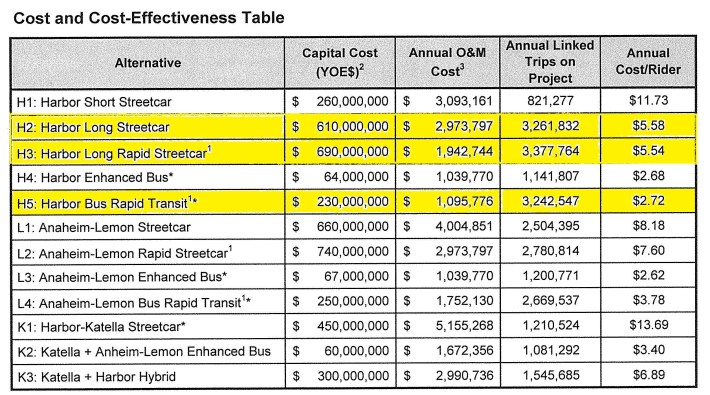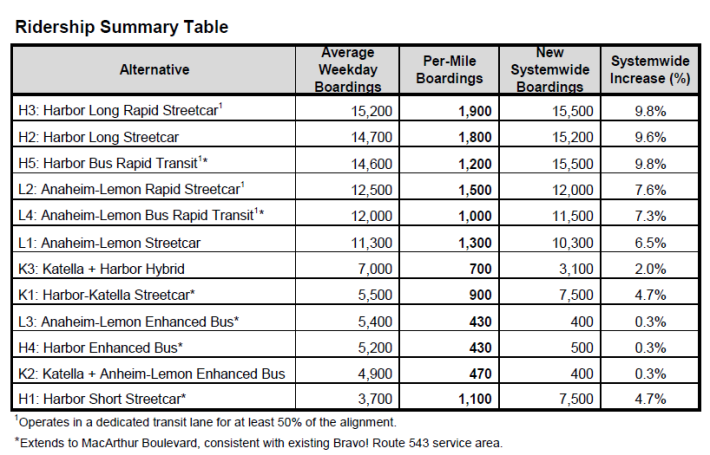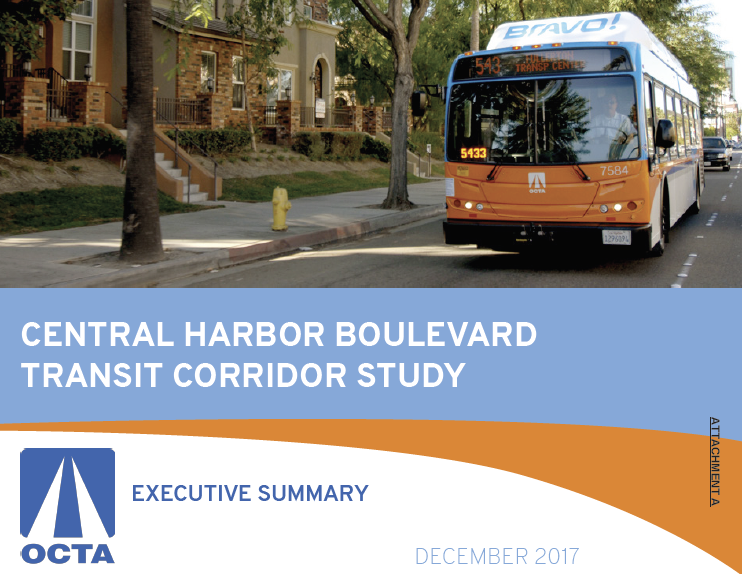Last week the Orange County Transportation Authority's board of directors approved a staff report that could bring the county a step closer to adding more streetcar line or building its first bus rapid transit.
Using OCTA's evaluation criteria, which included project performance, land uses, connectivity, infrastructure, mode choice, user experience, cost, transit modes, and corridor options, the report rated several transit options along the four-city study area. The top three were, in order: streetcar with a designated lane, streetcar in mixed traffic, and bus rapid transit with a designated lane. Note that the designated lane options were studied with only half of their routes separated from traffic. The top three options also support choosing a route along Harbor Boulevard: the streetcar options would run from the Fullerton Transportation Center (FTC) in the north to Westminster Avenue south (eight miles), and the BRT would follow the same route but end farther south, at MacArthur Boulevard (twelve miles).
For the past two years, OCTA staff have worked on the Central Harbor Boulevard Transit Corridor Study, an analysis of twelve different routes and mode options along the most heavily used transit corridor in the county. In addition to streetcar and BRT, the study also looked at an enhanced or "rapid" bus as well as a hybrid option, which includes a streetcar from Harbor/Westminster to the Anaheim Resort and enhanced bus from FTC to the Anaheim Regional Transportation Intermodal Center via Anaheim Boulevard/Lemon Street.
OCTA did not make an official recommendation at last week's meeting, because they still need to get feedback from Anaheim, Garden Grove, Santa Ana, and Fullerton city councils about the report's findings in the coming months, said OCTA planning director Kurt Brotcke.
To see the entire report, go here.
More than twelve percent of the region's bus riders travel through the Harbor corridor, making it the busiest north/south corridor in the county. In 2015, OCTA buses averaged more than 12,800 boardings per week on Harbor, 9,200 boardings on Anaheim Boulevard/Lemon Street between Fullerton and Newport Beach, and 4,200 boardings on Katella Avenue between Long Beach and Orange.
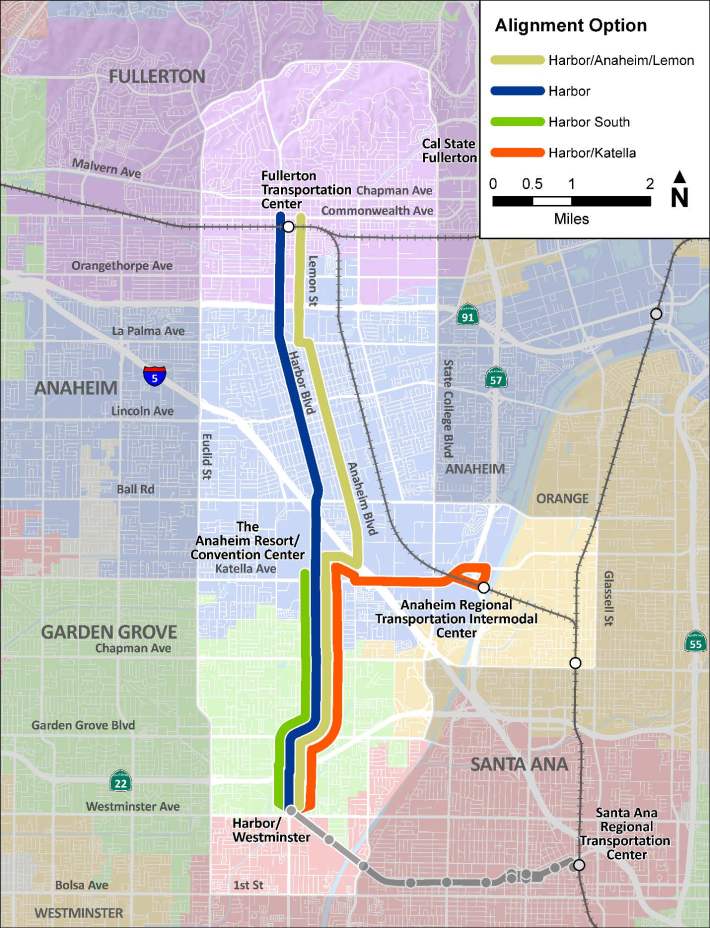
The report notes that adding travel lanes dedicated solely for transit would require further study. In feedback from the affected cities, there was no support for projects running in the center of the road, because the cities resist adding any additional right-of-way or changing the configuration of left-turn lanes.
Population and employment densities in the study area are double and triple the county averages, according to the study. More than half the properties in the project area are residential, with 36 percent of that low-density and twelve percent mid-to-high-density; nineteen percent are commercial, most of it concentrated around The Anaheim Resort, downtown Fullerton, and between State Route 22 and Ball Road along State College Boulevard; and twelve percent is industrial, located mostly along rail lines.
At the board meeting, as expected, multiple board members voiced concerns about whether the project would increase congestion or take away a travel lane. County Supervisor Michelle Steel, 2nd district, asked how the proposed projects could help curb congestion; Tim Shaw, OCTA's board vice chair and La Habra City Council member, asked whether a streetcar or BRT with designated lane would take away a travel lane "for vehicle traffic."
While congestion or right-of-way impacts weren't studied and require follow-up analysis, Brotcke said, future study needs to consider all roadway users. "In the next phase, I think everything will need to be on the table, as it relates to dedicated lanes for transit," Brotcke said. "We need to think of the needs of all users, the impact to adjacent land uses, vehicular traffic, bike users and, of course, pedestrians."
Last January, the Anaheim city council approved a resolution opposing any streetcar project along the former Anaheim Regional Connector project or along Harbor. At last week's meeting, Mayor Tom Tait doubled down on his city's opposition to any streetcar option, elaborating how a streetcar could take away a travel lane and speculating that no one would ride it because of its speed. Yet, Tait said, the city is in favor of doing something on Harbor — he expressed support for the enhanced bus option, which would mix with traffic, have priority at traffic signals, and use ticket machines at stations. "There's a lot of things that are happening that we would like. It could be monorail, it could be all sorts of things that we would like OCTA to look at, but not a streetcar," he said.
In past stories, Streetsblog has given a fair amount of flack to Darrel Johnson, CEO of OCTA, and OCTA planning staff for planning for cars while gutting bus service. But at this meeting, OCTA pushed back against car-centric planning. To one of Tait's comments, Johnson responded: "We have about eight buses an hour on Harbor Boulevard . . . that's a bus about every 7 1/2 minutes. Some are express, some are local. We could take that 7 1/2 minutes and make it 3 1/2 minutes, but we're not going to see significant changes in ridership. We may be at that saturation point. It's not to say that we couldn't do anything, but, again, if we decide [not to pursue a major change], we would focus our efforts on more of what we have today, which doesn't get us to that next level."
Johnson continued:
"What we're trying to do is have a conversation about what the community is interested in, what the cities are interested in. We think [the study] has more information than we had eight months ago and we'd like to go back to the city and talk about that."
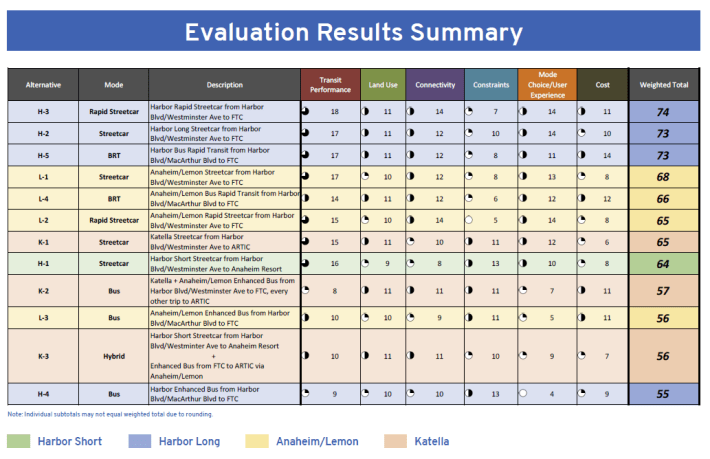
Other board members vocalized their support during this meeting, with Director Al Murray, Tustin city council member, said that even though he empathized with Anaheim's concerns around a streetcar, "we have to think regionally." Director Shawn Nelson, Fullerton city council member, said Anaheim's opposition shouldn't shroud the fact that only a few years ago the city was planning for ARC, and that local politics can derail local transit projects.
"Anaheim was spending its own money, and doing a study that was heading in a direction that made a lot of us nervous," Nelson said. "We decided that this board should do the laboring work to look at the big picture, be open-minded, and not get whipsawed by what the locals decided on any given moment until we got all the info, and not get caught up in a change in local politics."
The report received almost full support from the board, with the exception of Tait, who voted against it.
